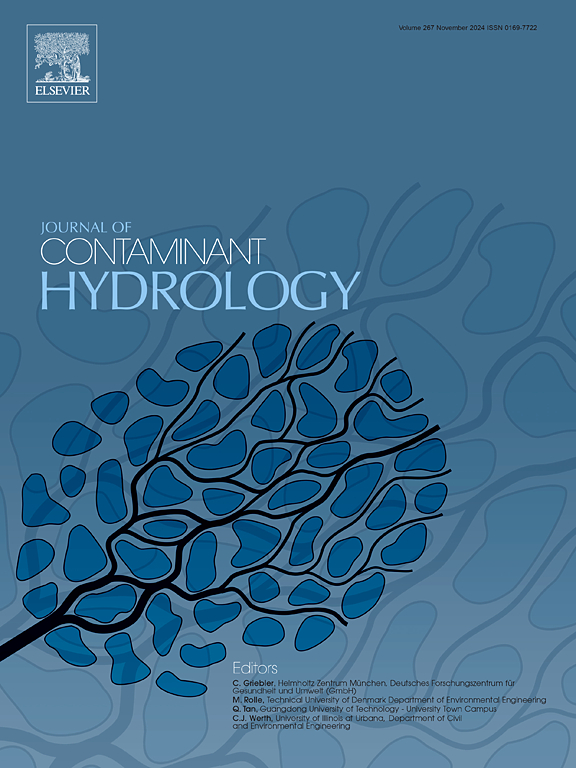Environmental impacts of organic residues from livestock management on soil and groundwater
IF 3.5
3区 环境科学与生态学
Q2 ENVIRONMENTAL SCIENCES
引用次数: 0
Abstract
Leaching nitrogenous compounds and total organic carbon (TOC) from livestock waste can contribute to long-term soil and groundwater quality degradation, particularly under rainfall-driven infiltration. This study investigates the behavior of these contaminants using a combination of laboratory-scale leaching, adsorption, and desorption experiments alongside pilot-scale field monitoring. Results indicate that organic residues derived from livestock waste processing release high concentrations of ammonium (NH₄+-N) and TOC even after extended rainfall exposure (up to 1600 mm). Subsequent desorption phases show nitrate (NO₃−-N) emerging as the dominant leached species over time, suggesting microbial transformation and increased subsurface mobility. Field observations confirm these trends, with gradual accumulation of NO₃−-N and TOC observed in groundwater near storage areas. This study addresses a significant knowledge gap regarding the long-term dynamics of contaminants originating from livestock waste. The findings underscore the importance of effective containment, consistent monitoring, and appropriate site management strategies to reduce potential impacts on water resources.
畜牧业有机残留物对土壤和地下水的环境影响
从畜禽粪便中浸出含氮化合物和总有机碳(TOC)会导致土壤和地下水质量长期退化,特别是在降雨驱动的渗透下。本研究结合实验室规模的浸出、吸附和解吸实验,以及中试规模的现场监测,调查了这些污染物的行为。结果表明,畜禽粪便处理产生的有机残留物即使在长时间降雨暴露(高达1600 mm)后也会释放高浓度的铵(NH₄+-N)和TOC。随后的解吸阶段显示硝酸盐(NO₃−-N)随着时间的推移成为主要的浸出物,这表明微生物的转化和地下流动性的增加。野外观测证实了这些趋势,在储存区附近的地下水中观测到NO₃−-N和TOC的逐渐积累。这项研究解决了关于源自牲畜废物的污染物长期动态的重大知识差距。研究结果强调了有效遏制、持续监测和适当场地管理战略的重要性,以减少对水资源的潜在影响。
本文章由计算机程序翻译,如有差异,请以英文原文为准。
求助全文
约1分钟内获得全文
求助全文
来源期刊

Journal of contaminant hydrology
环境科学-地球科学综合
CiteScore
6.80
自引率
2.80%
发文量
129
审稿时长
68 days
期刊介绍:
The Journal of Contaminant Hydrology is an international journal publishing scientific articles pertaining to the contamination of subsurface water resources. Emphasis is placed on investigations of the physical, chemical, and biological processes influencing the behavior and fate of organic and inorganic contaminants in the unsaturated (vadose) and saturated (groundwater) zones, as well as at groundwater-surface water interfaces. The ecological impacts of contaminants transported both from and to aquifers are of interest. Articles on contamination of surface water only, without a link to groundwater, are out of the scope. Broad latitude is allowed in identifying contaminants of interest, and include legacy and emerging pollutants, nutrients, nanoparticles, pathogenic microorganisms (e.g., bacteria, viruses, protozoa), microplastics, and various constituents associated with energy production (e.g., methane, carbon dioxide, hydrogen sulfide).
The journal''s scope embraces a wide range of topics including: experimental investigations of contaminant sorption, diffusion, transformation, volatilization and transport in the surface and subsurface; characterization of soil and aquifer properties only as they influence contaminant behavior; development and testing of mathematical models of contaminant behaviour; innovative techniques for restoration of contaminated sites; development of new tools or techniques for monitoring the extent of soil and groundwater contamination; transformation of contaminants in the hyporheic zone; effects of contaminants traversing the hyporheic zone on surface water and groundwater ecosystems; subsurface carbon sequestration and/or turnover; and migration of fluids associated with energy production into groundwater.
 求助内容:
求助内容: 应助结果提醒方式:
应助结果提醒方式:


